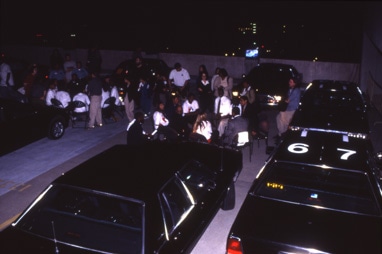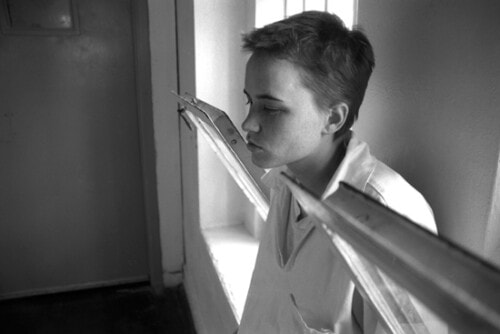I am the director of Center Kids, the family program of the LGBT Community Center. My partner and I and our infant son were one of the first families in the program in the fall of 1988, when we were still meeting in one other’s apartments and did not yet have a name or an affiliation with the center. I was a member of the program’s all-volunteer steering committee until I was hired as a part-time paid administrator in 1994, which became a full-time position in 1997.
When I look back on those years, I am overwhelmed at the river of faces and families that have poured through the program. It is their images and stories that brought me to the table to discuss my explosive personal frustration with the apparently single-minded struggle for same-sex marriage rights in our movement, when my work every day for so many years has only underscored how many of us would be left behind when a man was allowed to marry another man and a woman, another woman.
Here are some of the families that come into view in my mind’s eye:
-
Two lesbians, one inseminating with sperm provided by the father of the other.
-
Two gay men, with one baby through adoption, preparing to co-parent a new baby with a lesbian pregnant with an “adopted” embryo, along with the involvement of the heterosexual married couple that generated that embryo.
-
The lesbian and the gay man who made a baby together, moved to the suburbs where they looked for all the world like a conventional straight couple but were always forthrightly out about the nature of their relationship. They later had twins and brought the lesbian’s new partner into the house; all three adults openly cohabit and co-parent.
-
Gay men becoming fathers through surrogacy, where there is an increasing openness to—even longing for—ongoing, lifelong, familial relationships with surrogates, and often with the surrogate’s family as well.
-
Similarly, the ever-increasing number of lesbian and gay male couples conceiving children together, where all four parties seek legally recognized parental relationships when the law only allows two—as well as the countless, now commonplace “known donors” who become, to the surprise of all involved, active (if disempowered) fathers to their children.
-
My late partner’s lesbian daughter, her Swedish girlfriend, and their adopted African American daughter, Emilia—and Emilia’s birth mother, biological grandparents, and bio siblings—all of whom celebrate holidays and Emilia’s rites of passage together; and the increasing numbers of families embracing the deeply spiritual meaning and practice of open adoption, and the complex family relationships that result.
-
The six single, senior lesbian friends who took a hard look at the likely economic, health, and social challenges of their remaining years, and made a contractual commitment to care for one another until death—a contract they had to draft themselves, since there is no document in the legal canon that fit their situation.
-
The countless ex-lovers that, unlike most married folks, we continue to invite to our Thanksgiving dinners with their new partners, and with whom we possess a powerful, singular familial connection for which there is no name.
-
The rowdy, hilarious, defiant young people who sprawl in the hallways of the center every afternoon, who have patched together family groupings for mutual support in the absence of supportive families of origin; the remarkably sustaining alternative family structures for young trans people of the ball and house culture; and residential refuges such as Green Chimneys.
-
The households of three or more sexually intimate partners—an arrangement I have come to learn is more common than I first realized—but one that is often hidden from our surprisingly straitlaced and critical gay mainstream.
-
The dozens and dozens of families with multiple moms and dads due to separation, partner changing or blending, and the endless redefinition and shape-shifting nature of real family relationships, where some people stay and others sometimes go.
In the 2000 US Census, households with “unmarried partners” were counted for the first time in American history. LGBT organizations, for the first time in history, were able to use federal census data to count “same-sex households,” and have since been able to use this information to advocate for LGBT families. However, most, if not all, of the family relationships described above would have remained invisible in that count (not to mention that straight people cohabiting are counted in same-sex household data)—and they are not the minority! Only approximately 25 percent of US households are now comprised of a mother, father, and kids.1 The majority are single-parent households, grandparents raising kids, other kinship care arrangements, adults living alone, BFFs, friends with benefits, multiple-generation households, extended families, all those families described above, and more that none of us can imagine.
The point is: We as queers have been required, as we were forced to live our lives invisible in law, to get very creative in composing our families—and we rose to the occasion. Our families are often floridly odd, atypical, and vividly inventive. We have joined other disempowered groups in this nation who have been denied access to the right to marry, choose partners, retain partners, own property, or “legitimize” their offspring, in going off the grid to design our own alternative structures. To a large extent, these structures represent improvements over the patriarchal, property-passing system that, to a large extent, is marriage.
“The world is fixed,” we say; “fish in the sea, birds, in the air,” says anthropologist Loren Eiseley. “But, in the mangrove swamps by the Niger, fish climb trees and ogle uneasy naturalists, who try unsuccessfully to chase them back to the water. There are things still coming ashore.”
Queer families—along with “different” families of every stripe—are coming ashore, evolving and emerging and contributing to the anthropology of family. This evolution of family is thrilling and revolutionary.
Our outside-the-ordinariness is gorgeous—but it is illegitimate, and creates challenges and hardships because of too narrow definitions of family by law. Although I believe that those gay men and lesbians who want to be able to get married should be able to do so, I cannot ignore the images of those of us whose circumstances would not be improved remotely by privileging couplehood.
For instance, much of what exists in advocacy for LGBT families is for gay couples to have the ability to adopt children, in various states where they are unable to adopt openly. Yet communities of color have historically raised questions about a domestic adoption system that disproportionately removes black children from their homes and communities in the United States. American participation in wars like Vietnam has also been a major driver of transnational adoption. Any fight for primarily white gay and lesbian couples to gain increased access to adoption of poor children of color will increase tension with communities that are unfairly targeted by forced removal of children; or by conditions that make raising children more difficult, like massive incarceration, lack of health care, and high rates of unemployment.
Secondly, according to the 2000 US Census data, same-sex couples of color—especially lesbians of color, tend to have biological children at a similar rate to their straight counterparts, and are more likely to be poor than both straight people of that race, and white gays and lesbians.1 How is our work as a movement on behalf of LGBT families taking into consideration the race and class dynamics of many in our community who are raising their own children or for whom expensive assisted reproductive technologies are simply not an option?
For many years now, when describing the advocacy purposes of Center Kids, I mention our work—in schools, in the foster care system, on behalf of various forms of partnership rights, and so on—and then say, “but what we ultimately advocate for is an expanded, expansive, arms-flung-wide redefinition of the word ‘family,’” that rights are certainly appreciated, but they need to be rights that embrace the real range of who we are, and how we “family” (and I think for us, family is a verb).
How would I like to see these new families protected? I would like to see proactive legislation that allows individuals, LGBT or not, to name those nearest and dearest—sisters, brothers, nieces, nephews, domestic partners, or BFFs—as their Social Security beneficiaries. In fact, I would like all of the over 1,000 benefits presently attached to civil marriage to go to the people we determine and select, not only to spouses. In other words, I would like to see federal legislation that is designed to deliver benefits and rights based on my personhood rather than on whether or not I have been a winner in the dating game.
- Married-Couple and Unmarried-Partner Households: 2000 (PDF). Census 2000 Special Report, U.S. Census Bureau. (Accessed April 9, 2012). [↩] [↩]




